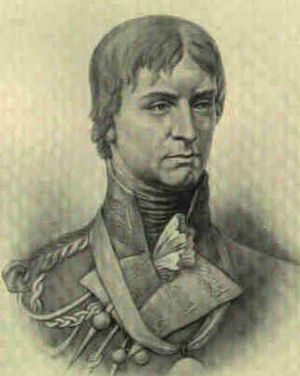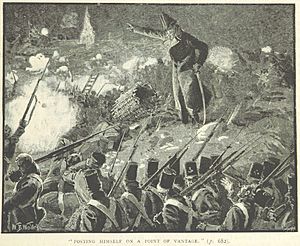Robert Craufurd facts for kids
Quick facts for kids
Major General Robert Craufurd
|
|
|---|---|
 |
|
| Nickname(s) | Black Bob |
| Born | 5 May 1764 Newark Castle, Ayrshire, United Kingdom |
| Died | 23 January 1812 (aged 47) Ciudad Rodrigo, Spain |
| Allegiance | United Kingdom |
| Service/ |
British Army |
| Rank | Major general |
| Relations | Craufurd baronets |
Robert Craufurd (born May 5, 1764 – died January 23, 1812) was a brave British soldier. He was born at Newark Castle in Scotland. Robert was the third son of Sir Alexander Craufurd. His older brother, Charles, was also a soldier.
Robert had a long military career. He served in places like India and the Netherlands. In 1810, during the Peninsular War against Napoleon, he was given an important job. He commanded the Light Division, which was made up of the army's best foot soldiers. These soldiers served under the famous Duke of Wellington. Craufurd was known for being very strict. He also had strong mood swings, which earned him the nickname "Black Bob." He was badly hurt while attacking the city of Ciudad Rodrigo in Spain on January 19, 1812. He died four days later.
Contents
Robert's Early Life
Robert Craufurd's family came from a place called Ayrshire in Scotland. His grandfather sold their family castle, Newark Castle. Robert's father, Alexander, later became a baronet, which is a special title. Robert's older brother, Charles, also chose a career in the British Army.
Robert's Military Career
Becoming a Young Soldier
Robert joined the army when he was just 15 years old in 1779. He started as an Ensign, which is a very junior officer. He spent four years learning the ropes. By the time he was 19, he was already leading a company of soldiers.
In 1782, Robert went to Berlin to study the army of Frederick the Great, a famous Prussian king. He even translated a book about war tactics into English. He and his brother Charles were even invited to watch Frederick the Great's troops train.
Early Battles and Important Roles
In 1787, Robert became a captain. He first saw real fighting in India between 1790 and 1792. He fought against Tippoo Sahib and was praised for his excellent service.
Because Robert knew German, which was rare for British officers, he got a special job. From 1794 to 1796, he worked as a military helper with the Austrian army.
In 1798, Craufurd was sent to Ireland. He helped stop the Irish Rebellion of 1798. Generals he worked with, like Cornwallis and Lake, told the War Office how good he was. A year later, he used his German skills again. He worked with the Russian army when they invaded Switzerland. At the end of 1799, he was part of a British mission to Holland.
Family and Politics
On February 7, 1800, Robert married Mary Frances. She was the granddaughter of a famous landscape designer. Robert loved his wife very much. He often asked for time off from the army to visit her. Sometimes, he even thought about leaving the army for good.
He also became good friends with William Windham, who was in charge of war matters. From 1801 to 1805, Craufurd was a member of Parliament. But in 1807, he quit to focus entirely on being a soldier.
The South American Expedition
In 1805, Robert was promoted to full colonel. He was put in charge of his own regiment. He was sent on a mission to South America. In 1806, he sailed to Rio de Janeiro. He was promised another promotion to Brigadier-General.
His group of soldiers included cavalry and infantry, about 4,200 men in total. Their goal was to conquer Chile. However, the British commander, John Whitelocke, was based in another city. When all the armies met in Buenos Aires in 1807, Whitelocke refused to attack. Robert Craufurd thought Whitelocke was a coward.
The British soldiers marched into the town. Craufurd wanted to attack the city walls, but his superior officer stopped him. The Spanish forces fought back hard. Craufurd's soldiers were surrounded and had to surrender. Many British soldiers were killed or hurt. Craufurd was very angry. He and another officer even offered to shoot Whitelocke when they returned home. Whitelocke made things worse by giving up another city and promising to leave the area.
Some people believed Whitelocke was a traitor. However, later investigations did not find strong proof of this.
Fighting in the Peninsular War
In 1808, Craufurd sailed to Spain to join the army of Sir John Moore. Their forces met in December 1808. Craufurd was given command of the 1st Flank Brigade. This group included the 43rd, 52nd, and 95th regiments.
News arrived that Napoleon's army was coming fast. Moore worried his army would be trapped. On December 24, he ordered a long retreat to the coast. Craufurd's Brigade was part of the rearguard, protecting the army from behind. They fought hard in the early parts of the retreat. There was little food. In freezing snow and fog, they marched very fast, fighting off much larger enemy forces.
On New Year's Day 1809, Craufurd's brigade climbed steep mountain passes. Many men died from hunger and cold. It was a very difficult journey, but they were not chased by the French. A week later, they were starving and in rags. They reached the port on January 12 and sailed for England.
One soldier, Rifleman Harris, wrote about Craufurd. He said Craufurd had a "severe look." But he also said Craufurd was "very attentive to the men." Even though Craufurd was very strict and would punish soldiers, his men admired him. Harris wrote that Craufurd was like "an iron man" and that "War was his very element." He believed Craufurd saved many lives with his leadership.
On May 25, 1809, Craufurd sailed to Portugal with his brigade. They arrived three weeks later. They marched to join the main army under Sir Arthur Wellesley. They marched incredibly fast, covering about 45 miles in 26 hours. This was in the hot Spanish summer, and the soldiers were in full gear. They were driven by the sound of cannons in the distance. Even though they marched so quickly, they arrived too late to fight in the Battle of Talavera.
In early 1810, Wellington learned that the French planned to attack Ciudad Rodrigo. He moved most of his army to northern Portugal. On March 1, Craufurd's Light Brigade became the Light Division. It started with 2,500 men and some cavalry. Later, 1,000 Portuguese soldiers joined them.
Wellington chose Robert Craufurd to guard the army's front line. He trusted Craufurd's skills. Wellington even asked for Craufurd's opinions on important matters. Craufurd was eager to prove himself. He wanted to show that Wellington's trust was well-placed.
The Light Division moved to the Spanish border. They guarded a 40-mile area against a much larger enemy force. From March to July 1810, Craufurd did an amazing job. He kept the French from breaking through his lines. He also stopped them from getting any information about the British army behind him. He was always in contact with the enemy but was never surprised. He never lost a small group of soldiers. He always knew what the enemy was doing and never gave his commander wrong information. This was because he had a very good system and was always alert.
The division was so well-trained that they could get ready to fight in just seven minutes, even in the middle of the night. They could be in battle formation in 15 minutes, with all their gear ready.
The first big test of Craufurd's system happened on March 19-20. French soldiers tried to sneak attack a bridge. They surprised the guards. But Craufurd's soldiers, the 95th Rifles, quickly got ready. They chased the French back across the river. The French lost many men, while the British lost only a few.
Craufurd's actions in 1810 were very bold. Sometimes, they were almost too risky. Wellington did criticize him once. But he also said, "I cannot accuse a man who I believe has meant well, and whose error was one of judgement, not of intention."
The Light Division's actions at the Battle of Buçaco were also very famous.
Craufurd spent the winter of 1810-1811 in England. When he returned for the battle of Fuentes de Oñoro, his men cheered for him. On May 5, 1811, the French attacked a weak part of Wellington's army. The Light Division and British cavalry helped save the day. They fought bravely while slowly moving back.
Robert Craufurd was promoted to Major-General on June 4, 1811.
Death at Ciudad Rodrigo
On January 19, 1812, Robert Craufurd was directing his soldiers during the attack on Ciudad Rodrigo. He was standing on the ground outside the fortress when he was shot and badly wounded. His staff officer carried him away from the fighting. He lived for four more days but then died.
He was buried in the very spot where he was wounded inside the fortress. A monument in St Paul's Cathedral in London remembers Craufurd and another general who died at Ciudad Rodrigo.
Major-General Craufurd was known as 'Black Bob'. This nickname might have come from his habit of using strong language when he was angry. It also referred to how strict he was and even his dark facial hair. Later, during the First World War, a warship was named after him, HMS General Craufurd.


